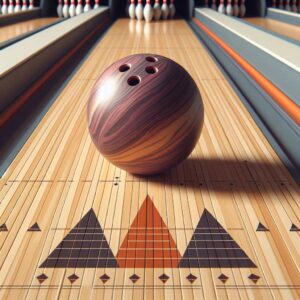For many bowlers, the classic 10 pin format is the standard game they’ve grown up with and perfected. However, there’s another lesser-known but equally exciting style of bowling that’s gaining popularity – 9 pin bowling.
This unique variation of the sport has its own distinct rules, gameplay, and strategies that make it a thrilling experience for both casual and competitive players.
In this comprehensive guide, we’ll dive deep into the world of 9 pin bowling. We’ll cover the basics of what this format entails, explain the key rules and scoring system, and provide tips to help you improve your 9 pin bowling skills.
Whether you’re a seasoned bowler looking to try something new or a complete beginner, this article has everything you need to master the art of 9 pin bowling.
What is 9 Pin Bowling?
9 pin bowling, also known as 9 pin no-tap bowling, is a variant of the traditional 10 pin bowling game. The primary difference lies in the number of pins set up on the lane – instead of the standard 10, 9 pin bowling uses, well, 9 pins.
The origins of 9 pin bowling can be traced back to the early 1900s, when it gained popularity as an alternative to the classic 10 pin format, particularly in parts of the Midwestern United States. Over the years, 9 pin bowling has evolved and spread to various regions, becoming a beloved pastime for casual bowlers and competitive leagues alike.
How 9 Pin Bowling Differs from 10 Pin Bowling
While the basic premise of knocking down pins with a rolling ball remains the same, there are several key differences between 9 pin and 10 pin bowling:
Pin Configuration: In 10 pin bowling, the pins are set up in a triangular pattern with 10 pins in total. In 9 pin bowling, the pins are arranged in a diamond shape with only 9 pins.
Scoring: The scoring system in 9 pin bowling differs from the traditional 10 pin format. We’ll dive deeper into the scoring rules later in this guide.
Gameplay: The number of balls per frame, as well as the criteria for strikes and spares, varies between the two formats.
Equipment: 9 pin bowling typically uses a slightly smaller bowling ball compared to the standard 10 pin ball. The pins themselves are also slightly smaller in size.
These key differences create a unique playing experience that challenges bowlers to adapt their skills and strategies to the 9 pin format.
The 9 Pin Bowling Lane and Equipment
To fully understand the rules and gameplay of 9 pin bowling, it’s important to familiarize yourself with the lane setup and equipment used.
The 9 Pin Bowling Lane
A 9 pin bowling lane is similar in length and width to a traditional 10 pin lane, typically measuring 60 to 62 feet in length and 42 inches in width. However, the pin setup is different, as mentioned earlier.
The 9 pins are arranged in a diamond formation, with the front pin positioned directly in the center of the lane. The remaining 8 pins are placed in a symmetrical pattern around the central pin, creating a more compact and challenging target for bowlers to aim for.
9 Pin Bowling Equipment
In addition to the lane setup, 9 pin bowling also utilizes specific equipment:
Bowling Ball: 9 pin bowling balls are typically slightly smaller and lighter than their 10 pin counterparts. The most common ball weights range from 6 to 16 pounds, with 10 to 14 pounds being the most common.
Bowling Pins: The 9 pins used in this format are slightly shorter and narrower than standard 10 pin bowling pins. They are typically made of wood or plastic and have a distinct diamond-shaped configuration.
Approach Area: The approach area in a 9 pin bowling lane is generally the same length as a 10 pin lane, allowing bowlers to take their full approach before releasing the ball.
Understanding the unique lane setup and equipment used in 9 pin bowling will help you better navigate the rules and strategies of this dynamic sport.
9 Pin Bowling Scoring
The scoring system in 9 pin bowling differs significantly from the traditional 10 pin format. Let’s take a closer look at how the points are calculated.
Basic Scoring
In 9 pin bowling, each frame consists of two rolls, similar to 10 pin bowling. The objective is to knock down as many of the 9 pins as possible with each roll. The scoring is as follows:
- If you knock down all 9 pins with the first roll, it’s considered a “strike” and you’ll receive 30 points.
- If you knock down all 9 pins with the second roll, it’s considered a “spare” and you’ll receive 10 points, plus the number of pins knocked down on your next roll.
- If you don’t knock down all 9 pins in the two rolls, you’ll receive the number of pins you did manage to knock down.
Calculating the Final Score
The total score in a 9 pin bowling game is determined by the number of pins knocked down in each frame, as well as any bonus points earned for strikes and spares.
Here’s an example of how the scoring works:
- Frame 1: 8 pins knocked down on the first roll, 1 pin knocked down on the second roll. Total score for the frame is 9 points.
- Frame 2: You knock down all 9 pins on the first roll, earning a strike. You receive 30 points for the strike, plus the number of pins knocked down on your next two rolls.
- Frame 3: You knock down 7 pins on the first roll and 2 pins on the second roll, earning a spare. You receive 10 points for the spare, plus the number of pins knocked down on your next roll.
The scoring continues in this fashion throughout the game, with bonus points awarded for strikes and spares. The final score is the total number of points earned across all 10 frames.
It’s important to note that in 9 pin bowling, a “perfect” game score is 270 points, as opposed to 300 points in traditional 10 pin bowling.
Handicaps and Averages
In 9 pin bowling leagues and tournaments, handicaps and averages play a crucial role in the scoring and competition.
A handicap is an additional number of pins added to a bowler’s score to level the playing field. Handicaps are typically based on a bowler’s established average score, with higher-skilled players receiving lower handicaps.
Maintaining a consistent 9 pin bowling average is essential for determining appropriate handicaps and ensuring fair competition. Bowlers are encouraged to track their average scores over time to optimize their handicap and improve their overall performance.
Understanding the unique scoring system and the role of handicaps and averages is key to mastering the art of 9 pin bowling.
Key 9 Pin Bowling Rules
Now that we’ve covered the basics of 9 pin bowling, let’s dive into the essential rules that govern this dynamic sport.
Gameplay
- Order of Play: In a standard 9 pin bowling game, players take turns rolling the ball, with each frame consisting of two rolls.
- Number of Balls per Frame: Unlike 10 pin bowling, where three balls are allowed in the 10th frame, 9 pin bowling limits each frame to a maximum of two balls.
- Knocking Down All 9 Pins: The primary objective in 9 pin bowling is to knock down all 9 pins with either the first or second roll of the frame.
Spares and Strikes
- Spare: A spare is earned when a bowler knocks down all 9 pins with their second roll of the frame. Spares are worth 10 points, plus the number of pins knocked down on the next roll.
- Strike: A strike is achieved when a bowler knocks down all 9 pins with their first roll of the frame. Strikes are worth 30 points, plus the number of pins knocked down on the next two rolls.
Foul Lines and Penalties
- Foul Lines: In 9 pin bowling, as in 10 pin bowling, there are foul lines that players must not cross during their delivery. Crossing the foul line results in a foul, which can have various penalties depending on the specific rules of the bowling center or league.
- Penalty for Fouls: Committing a foul typically results in the bowler’s current roll being scored as a zero, with no points awarded for that frame. However, the specific penalty for fouls may vary, so it’s important to familiarize yourself with the local rules.
Handicaps and Averages
- Handicap Calculation: Handicaps in 9 pin bowling are typically calculated based on a bowler’s established average score. The specific formula for determining handicaps may vary between bowling centers and leagues.
- Maintaining Averages: Bowlers are encouraged to track and maintain their 9 pin bowling averages over time. These averages are used to calculate appropriate handicaps and ensure fair competition in leagues and tournaments.
Understanding these key rules is essential for both new and experienced 9 pin bowlers to navigate the game effectively and maximize their scoring potential.
Tips for Improving at 9 Pin Bowling
Now that you have a solid understanding of the rules and mechanics of 9 pin bowling, let’s explore some tips and strategies to help you improve your game.
Technique for Rolling the Ball
- Proper Grip: Ensure you have a comfortable and consistent grip on the bowling ball, with your fingers properly inserted into the holes. This will give you better control and stability during your delivery.
- Consistent Approach: Develop a repeatable approach, including your steps and timing, to ensure a smooth and consistent release of the ball.
- Aim for the Center Pin: In 9 pin bowling, the key is to target the central pin, as knocking it down will often lead to a domino effect and clear the remaining pins.
Strategies for Knocking Down All 9 Pins
- Analyze the Pin Layout: Carefully observe the position of the remaining pins after your first roll and develop a plan to effectively knock them all down on your second roll.
- Adjust Your Aim: Based on the pin layout, make subtle adjustments to your aim and ball trajectory to maximize the chances of a strike or spare.
- Leverage Spin and Curve: Experiment with different ball releases, such as adding spin or creating a hook, to find the most effective technique for your playing style and the lane conditions.
Advice for Beginner and Intermediate Players
- Practice Regularly: The more you bowl, the more comfortable and consistent you’ll become with the 9 pin format. Dedicate time to regular practice sessions to refine your skills.
- Learn from Experienced Players: Seek guidance and advice from seasoned 9 pin bowlers, whether it’s through lessons, leagues, or simply observing their techniques.
- Focus on Fundamentals: Ensure you have a solid grasp of the basic 9 pin bowling rules, scoring, and techniques before attempting more advanced strategies.
- Track Your Progress: Keep a record of your scores and averages to monitor your improvement over time. This will help you identify areas for further development and set achievable goals.
By incorporating these tips and strategies into your 9 pin bowling practice and gameplay, you’ll be well on your way to mastering this dynamic and engaging sport.
Conclusion
In this comprehensive guide, we’ve explored the fascinating world of 9 pin bowling – its history, unique rules, scoring system, and strategies for improving your game.
From understanding the distinct lane setup and equipment to navigating the nuances of strikes, spares, and handicaps, you now have a solid foundation to dive into the thrilling experience of 9 pin bowling.
Whether you’re a seasoned bowler looking to try something new or a complete beginner eager to explore this lesser-known variant, we hope this guide has provided you with the knowledge and inspiration to embrace the challenges and rewards of 9 pin bowling.
So gather your friends, lace up your bowling shoes, and get ready to experience the excitement and camaraderie of this captivating sport. Who knows, you might just discover a new favorite way to spend your time on the lanes!





